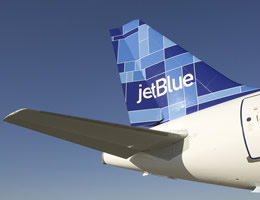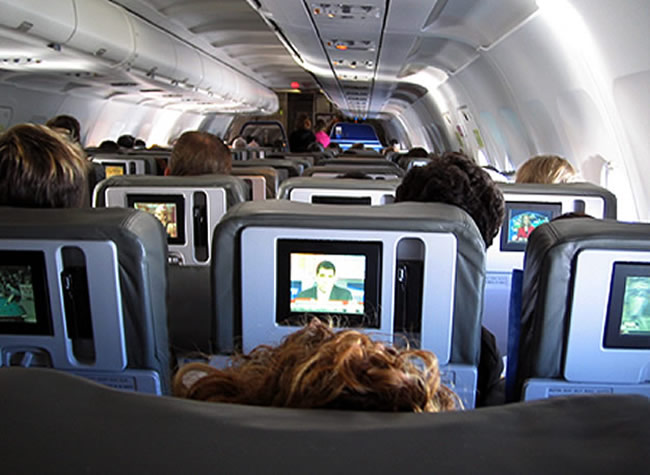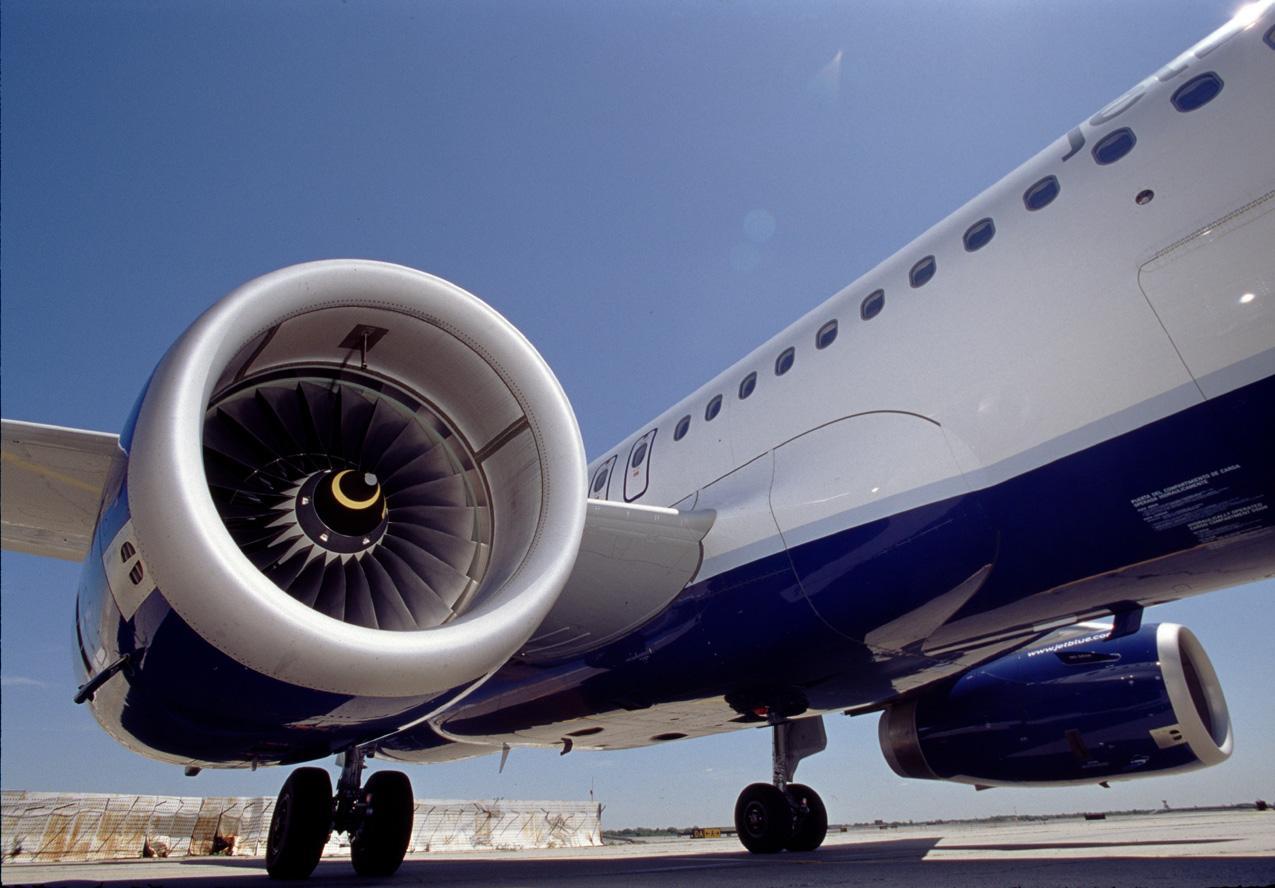JETBLUE AIRWAYS INFORMATION HISTORY PICTURES AND FACTS
 |
 |
 |
jetBlue AIRWAYS
JetBlue Airways is a major American low-cost airline owned by JetBlue Airways Corporation (NASDAQ: JBLU).The company is headquartered in the Forest Hills neighborhood of the borough of Queens in New York City. Its home airport is John F. Kennedy International Airport. JetBlue is a non-union airline. In October, 2007, JetBlue was named the number one U.S. domestic airline by Conde Nast Traveler magazine's "Readers' Choice Awards" for the sixth year in a row. In 2001, JetBlue began a focus city operation at Long Beach in Los Angeles County, and another at Logan International Airport, Boston in 2004. It also has focus city operations at Fort Lauderdale, Oakland International Airport, and at Washington-Dulles, as well as substantial operations at Orlando International Airport. The airline mainly serves destinations in the United States, along with flights to the Caribbean, the Bahamas, Bermuda, and Mexico. JetBlue also maintains a corporate office in Cottonwood Heights, Utah and a satellite office in Darien, Connecticut. History Founding In September 1999 the airline was awarded 75 initial take off/landing slots at John F. Kennedy International Airport, and received formal U.S. authorization in February 2000. It started operations on 11 February 2000. JetBlue's founders had set out to call the airline "Taxi" and therefore have a yellow livery to associate the airline with New York. The idea was dropped, however, for several reasons: the negative connotation behind New York City taxis; the ambiguity of the word taxi with regard to air traffic control; and threats from investor JP Morgan to pull its share ($20 million of the total $128 million) of the airline's initial funding unless the name was changed. The airline's founders also considered making its home base in Trenton, New Jersey, but this idea did not gain much support. 9/11 aftermath, profitable years In 2002, JetBlue acquired LiveTV, LLC for $41 million in cash and the retirement of $39 million of LiveTV debt. LiveTV equips JetBlue with 36 channels of live DirecTV satellite TV programming at every seat. Two years later, JetBlue announced it would add 100 channels of XM Satellite Radio, Fox TV programs and 20th Century Fox movies to its in-flight entertainment. The movies are free on flights outside of the U.S. mainland (as DirecTV service is not available), and are available for a small fee on other flights. JetBlue has not yet attempted to raise money by selling snacks during flights, a move that many larger airlines have made on domestic flights and some international flights. JetBlue has also told customers in commercials and print ads that they "encourage you to use the call button", advertising their devotion to customer service. JetBlue is also known for its "letter ads", for example: "Dear New York", and ending with "Sincerely, JetBlue". As the airline continued to make record profits, new planes allowed for additional route opportunities. These included JetBlue's first international service, New York City to the Dominican Republic, on June 10, 2004. Additional service to the Bahamas began on November 1, 2004, and service to Bermuda began May 4, 2006. Service to Aruba began September 15, 2006. In 2004, JetBlue began flights from New York City's LaGuardia Airport and added service in 2005 to Newark Liberty International Airport in Newark, New Jersey, thereby serving all three major New York City area airports. Also in 2005, the company added service between JFK and Boston Logan with 10 daily flights using its new 100-seat Embraer 190 aircraft. In October 2006 JetBlue announced they would begin service from Stewart International Airport, in Newburgh. Later, the airline announced new service to Westchester County Airport, also known as White Plains, allowing JetBlue access to five of the six New York City area airports. Developments since 2005 Regardless, the airline continued to plan for growth. It was announced that 36 new aircraft were scheduled for delivery in the year 2006. However, trouble was on the horizon. For many years, analysts had predicted that JetBlue's growth rate would become unsustainable. Despite this, the airline continued to add planes and routes to the fleet at a brisk pace. In addition in 2006, the IAM (International Association of Machinists) attempted to unionize JetBlue's "ramp service workers", in a move that was described by JetBlue's COO Dave Barger as "pretty hypocritical", as the IAM opposed JetBlue's creation when it was founded as New Air in 1998. The union organizing petition was dismissed by the National Mediation Board because fewer than 35 percent of eligible employees supported an election. In February 2006, JetBlue announced its first ever quarterly loss. For 4th quarter 2005, the airline lost $42.4 million, enough to make them unprofitable for the entire year of 2005. The loss was the airline's first since going public in 2002. JetBlue also reported a loss in the 1st quarter 2006. In addition to that, JetBlue forecast a loss for 2006, citing high fuel prices, operating inefficiency, and fleet costs. During the first quarter report, CEO David Neeleman, President Dave Barger, and then-CFO John Owen released JetBlue's "Return to Profitability" ("RTP") plan, stating in detail how they would curtail costs and improve revenue to regain profitability. The plan called for $50 million in annual cost cuts and a push to boost revenue by $30 million. JetBlue Airways moved out of the dark during the second quarter of 2006, beating Wall Street expectations by announcing a net profit of $14 million. That result was flat when compared to JetBlue’s results from the same quarter a year ago ($13 million), but it was double Wall Street forecasts of a $7 million profit, Reuters reports. The carrier said cost-cutting and stronger revenue helped it offset higher jet fuel costs. In October 2006, JetBlue announced a net loss of $500,000 for Quarter 3, and a plan to regain that loss by deferring some of their E190 deliveries, and by selling 5 of their A320s. In December 2006, JetBlue announced another component of the RTP, when they explained the reasoning behind their decision to remove a row of seats off their A320s. The removal of the seats will lighten the aircraft by 904 lb (410 kg), and will reduce the inflight crew size from four to three (per FAA regulation requiring one flight attendant per 50 seats), thus offsetting the lost revenue from the removal of seats, and further lightening the aircraft, resulting in less fuel burned. In January 2007, JetBlue announced it had returned to profitability with a fourth quarter profit for 2006, reversing a quarterly loss in the year-earlier period. As part of the RTP plan, 2006's full year loss was $1 million compared to 2005's full year loss of $20 million. JetBlue was one of the few major airlines to post a profit in the quarter. On May 10, 2007, JetBlue announced Barger's appointment as CEO, who also retains the position of President. Neeleman, who was named non-executive Chairman of the Board, said "This is a natural evolution of our leadership structure as JetBlue continues to grow. As Chairman of the Board of Directors, I will focus on developing JetBlue's long-term vision and strategy, and how we can continue to be a preferred product in a commodity business." On July 24, 2007, JetBlue reported that its second-quarter revenue increased to $730 million, compared to $612 in 2006. Second quarter net income grew to $21 million for the quarter, from $14 million the previous year. CEO David Barger said the airline will take delivery of three fewer planes this year and will sell three planes from their current fleet, "slowing capacity growth...to strengthen our balance sheet and facilitate earnings growth", but will continue to add two to four new destinations each year. In July 2007, the airline partnered with 20th Century Fox's film "The Simpsons Movie" to become the "Official Airline of Springfield". In addition a contest was held in which the grand prize would be a trip on jetBlue to Los Angeles to attend the premiere of the film. The airline's website was also redecorated with characters and their favorite JetBlue destinations and the company was taken over by the show/film's greedy businessman villain C. Montgomery Burns. In August 2007, the airline announced the addition of exclusive content from The New York Times in the form of an in-flight video magazine, conducted by Times' journalists and content from NYTimes.com. On October 11, 2007, JetBlue announced expanded service to the Caribbean with service to St. Maarten and Puerto Plata commencing January 10, 2008. With these additional destinations, JetBlue's service expands to a total of eleven Caribbean/Atlantic destinations including Aruba; Bermuda; Cancun; Nassau; Aguadilla, Ponce and San Juan, Puerto Rico; and Santiago and Santo Domingo, Dominican Republic. JetBlue will serve 56 destinations in eight countries by early 2008. On November 8, 2007, JetBlue announced the appointment of Ed Barnes as interim CFO, following the resignation of former CFO John Harvey. In 2008, JetBlue, which has its main passenger terminal in Terminal 6 at JFK, will be moving all operations to the adjacent TWA Flight Center which has been under renovation by the airline since late 2005. On December 13, 2007, JetBlue and German-based Lufthansa announced their intent to sell 19% of JetBlue to Lufthansa, pending approval from US regulators. Following the acquisition, Lufthansa stated they plan to seek operational cooperation with JetBlue. TrueBlue Membership JetBlue has categorized flights into 3 categories: SHORT (2 pts): Flights from JFK to Buffalo, NY Destinations In 2006, JetBlue launched service to Pittsburgh, Charlotte, Raleigh, Nashville, Bermuda, and Aruba. JetBlue received authority to serve Cancún, Mexico, after having competed for the route against Delta Air Lines and USA 3000. JetBlue also began service to Houston-Hobby, Sarasota, Columbus, and Tucson. In the fall of 2007, JetBlue announced that it was pulling out of Columbus and Nashville. JetBlue Airways at Cibao International Airport, Santiago, DR, just arrived from New YorkPrior to the passage of the Wright Amendment Reform Act of 2006, JetBlue expressed an interest in serving Dallas Love Field's customers if the Wright Amendment was repealed. It has also expressed refusal to serve Dallas-Fort Worth International Airport on the grounds that it does not wish to contend with American Airlines, which has a dominating presence there. On August 17, 2006, service between New York JFK and Washington-Dulles commenced, finalizing JetBlue's plan to connect the three major Northeast cities of Boston, New York, and Washington DC, and also putting pressure on the airlines that operate those routes, namely Delta Shuttle and US Airways Shuttle. Washington-Dulles offers eight nonstop destinations, and with the addition of service to New York-JFK, 45 destinations via connection in New York. JetBlue has announced service to/from White Plains, New York. With this addition, JetBlue now serves five out of six airports in the New York City area. In October 2006, JetBlue applied to the FAA for landing rights at Chicago's O'Hare Airport for eight flights per day. Almost immediately, United Airlines filed an objection, claiming JetBlue "did not follow proper procedures and should be denied". On October 16, 2006, JetBlue received approval from the FAA to land at O'Hare, though the number of slots requested was cut in half to four flights per day. JetBlue also bought three additional O'Hare slots from other carriers, and service to New York/JFK and Long Beach started January 4, 2007. Alliances Codeshares New routes Fleet As of December 2007, the average fleet age of JetBlue Airways was 3.2 years. Nearly every plane in JetBlue's fleet is named with a designation containing some form of the word "blue". Examples include "Absolute Blue", "Big Blue Bus", "Blue Suede Shoes", "Canyon Blue", "Mi Corazon Azul", "Rhapsody in Blue", "Sacre Bleu!", "The name is Blue, JetBlue", and "Whole Lotta Blue". However as of November 2006, there are two exceptions: tail number N190JB is "Luiz F. Kahl", named for the former Chairman of the Niagara Frontier Transportation Authority, and tail number N533JB is "Usto Schulz", named for JetBlue's former VP of Safety. Every year employees submit suggestions for the names of the new planes. Past winners have received trips to Toulouse, France, to tour the Airbus hangar and fly home aboard the plane that bears their name suggestion. Some long-term maintenance on JetBlue's Airbus A320 aircraft is conducted at Aeroman, a facility in El Salvador owned by Air Canada. At one time, Aeroman was owned by Grupo TACA, who is also a major Airbus A320 operator. JetBlue also uses Air Canada's facilities in Canada, along with Empire Aero Center in Rome, NY. In the early years of the airline, founder David Neeleman said he always sat in the last row (row 27) of each Airbus A320 aircraft when flying on his company's airplanes, to demonstrate that pleasing the customer is more important than pleasing the CEO (at the time, seats in the 27th row — since removed from JetBlue's A320 airplanes — did not recline). In December 2006, JetBlue announced they would be removing one more row of seats from their A320s, reducing the number of seats to 150. They also revealed they would adjust the remaining rows in the forward half of the cabin, increasing the seat pitch to 36 inches (91 cm), giving passengers more legroom than any other coach carrier. Fleet modifications have been completed as of February 8, 2007. At present, the A320 has a seat pitch of 36 inches (91 cm) in rows 1–11, and 34 inches (86 cm) in rows 12–25, with slightly more than 36 inches (91 cm) in the two exit rows. The E190 has a seat pitch of 32 inches (81 cm) in rows 1–10, and 33 inches (84 cm) in rows 13–25, with a pitch of more than 34 inches (86 cm) in the exit rows. The seat width on the A320 is 17.8 inches (45.2 cm), and the seat width on the E190 is 18.25 inches (46.4 cm). In July 2005, JetBlue announced that it would be upgrading the size of its seatback TVs that provide customers with DirecTV programming. All new aircraft are being equipped with the larger seatback TVs, and older aircraft are being retrofitted. The E190s are all equipped with XM satellite radio, and the A320s are being XM equipped when each aircraft's TV screens are being upgraded. In addition, the airline aims to increase the size of the overhead bins on all aircraft. Unlike the A320 fleet that JetBlue uses where the flight attendant has to read the safety briefing, the E190 fleet uses a pre-recorded audio safety briefing to accompany the live demonstration. Employees Incidents JETBLUE AIRWAYS ENTERTAINMENT Known as much for its free TV as its low fares, JetBlue was the first carrier to offer satellite TV at every seat. It serves 53 cities with up to 525 daily flights and now includes routes to Aruba, all on a fleet of Airbuses outfitted with leather seats and the most leg room in coach. JetBlue Airways Video: You can watch 36 free channels of DirecTV, including the new Times On Air channel from The New York Times. If that's not enough, you can spend $5 to view a first-run movie on one of the three Fox InFlight Premium Entertainment channels. JetBlue Airways Music: More than 100 channels of XM Satellite Radio for free, a godsend if you want a lot of audio variety JetBlue Airways Games: N/A JetBlue Airways Power: No on-plane power, but does offer free Wi-Fi at its New York (JFK) and Long Beach, CA (LGB) terminals. JetBlue has the potential to be a contender for the geek-friendliest airline around, assuming it can add MP3s and games to the mix. JetBlue offers each passenger a personal video screen that can play 36 channels of DirecTV and more than 100 channels of XMRadio. There is also a pay-per-view selection of movies and a video magazine created by the New York Times. |
ARE YOU WONDERING WHERE YOUR AIRPLANE SEAT IS LOCATED ON YOUR NEXT AIRLINE FLIGHT? Air Canada Airlines Aircraft Seatmaps | American Airlines Airplane Seating Charts | British Airways Aircraft Seating Maps |
© AviationExplorer.com - The Website For Aviation Enthusiasts |








